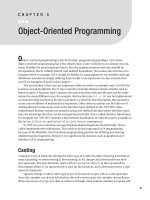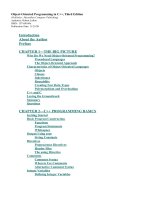Lecture Object oriented programming - Lecture No 03
Bạn đang xem bản rút gọn của tài liệu. Xem và tải ngay bản đầy đủ của tài liệu tại đây (130.21 KB, 24 trang )
CSC241: Object Oriented Programming
Lecture No 03
1
Previous Lecture
•
Simple C++ program using cin and cout
•
Member function with parameters
–
GradeBook class
–
Book class
–
Distance class
•
Set functions and get functions
•
A little about Constructor
2
Today’s Lecture
•
Constructor – example program
•
Placing class in separate file
•
Destructor – example program
•
Constructor with arguments – example program
3
Example program – Distance class
•
•
Data members
–
Feet
–
Inches
Member functions
–
void setdist(int ft, float in);
–
void getdist();
–
void initialize();
–
void showdist();
Go to
program
4
Distance class – data member
initialization
•
•
•
•
Distance class shows two ways to initialize the
data items in an object
–
void initialize();
–
void setdist(int ft, float in);
Can an object be initialized whenever it is
created, without requiring a separate call to a
member function?
Automatic initialization is carried out using a
special member function called a constructor.
A constructor is a member function that is
executed automatically whenever an object is
5
Constructors
•
•
•
•
C++ requires a construct call for each object it
has created
This ensure that object is initialized properly
before it is used
If there is no constructor, the compiler provides a
default constructor that is, a constructor with
no parameters
Name of constructor function is same as name
of class
6
A counter example
•
Data member
–
•
Count
Member function
–
Constructor
–
void inc_count()
–
int get_count()
7
Automatic initialization
•
•
•
An object of type Counter is first created, we
want its count to be initialized to 0
Options are
–
set_count() function (call it with an argument of 0)
–
zero_count() function, to set count to 0.
Such functions would need to be executed every
time we created a Counter object
8
Cont.
•
•
•
•
A programmer may forget to initialize the object
after creating it
It’s more reliable and convenient to cause each
object to initialize implicitly when it is created
In the Counter class, the constructor Counter() is
called automatically whenever a new object of
type Counter is created
Counter c1, c2;
creates two objects. Constructor is called with
Go to
each object separately
program
9
Constructor Name
•
First, constructor name must be same as the
name of class
–
•
This is one way the compiler knows they are
constructors
Second, no return type is used for constructors
–
Why not? Since the constructor is called automatically
by the system, there’s no program for it to return
anything to; a return value wouldn’t make sense
–
This is the second way the compiler knows they are
constructors
10
Initializer List
•
•
•
•
One of the most common tasks a constructor
carries out is initializing data members
In the Counter class the constructor must
initialize the count member to 0
The initialization takes place following the
member function declarator but before the
function body.
Initialization in constructor’s function body
Counter()
{ count = 0; }
11
Cont.
•
It’s preceded by a colon. The value is placed in
parentheses following the member data.
Counter() : count(0)
{ }
•
If multiple members must be initialized, they’re
separated by commas.
–
someClass() : m1(7), m2(33), m2(4) ←initializer list {
}
12
Placing a Class in a Separate File
•
•
Header file (.h)
–
Contain definition of class
–
Not an executable file
–
Included in .cpp file
main () file (.cpp)
–
Include .h file containing class definition
–
Executable file
Go to
program
13
Destructors
•
•
•
•
Destructor is a function called implicitly when an
object is destroyed
The name of the destructor for a class is the
tilde character (~) followed by the class name
No arguments and no return type for a
destructor
The most common use of destructors is to
deallocate memory that was allocated for the
object by the constructor
Write a CreatAndDistroy
class
14
Validating Data with set Functions
•
•
A set function should validate the value before
assigning to private data member
Set function can return a value or may display a
message if invalid data is assign to object
Go to
program
15
Constructor with default arguments
Go to
program
16
Objects as Function Arguments
class Distance { //Distance class
private:
int feet;
float inches;
public:
Distance() : feet(0), inches(0.0)
{}
Distance(int ft, float in) : feet(ft),
inches(in)
{}
void getdist(){
cout << “\nEnter feet: “; cin >>
feet;
cout << “Enter inches: “; cin >>
inches;
}
void showdist(){
cout << feet << “:” <<
inches<
void Distance::add_dist(Distance
d2, Distance d3) {
inches = d2.inches +
d3.inches;
feet = 0;
if(inches >= 12.0) {
inches -= 12.0;
feet++;
}
feet += d2.feet + d3.feet;
}
main()
{
Distance dist1, dist3;
Distance dist2(11, 6.5);
dist1.getdist();
dist3.add_dist(dist1, dist2);
cout << “\ndist1 = “;
dist1.showdist();
cout << “\ndist2 = “;
dist2.showdist();
17
18
Cont.
main()
dist1
{
feet
Distance dist1, dist3;
inche
Distance dist2(11, 6.5);
s
dist1.getdist();
dist3.add_dist(dist1, dist2);
dist2
cout << “\ndist1 = “;
dist1.showdist();
feet
inche
cout << “\ndist2 = “;
dist2.showdist();
s
cout << “\ndist3 = “;
void
Distance::add_dist(Distance
void
showdist(){
dist3.showdist();
getdist(){
d1
d2)
{
}d1, Distance
cout
<<
feet
<<
“:”
<<
cout << “\nEnter feet: “; cin >>
inches
feet
inches<
feet; = d1.inches
inche
d2.inches;
} cout << “Enter inches: “; cin >>
feet = 0;
s
dist1
=
5
:
7.0
inches;
if(inches >= 12.0) {
} inches -= 12.0;
dist2feet++;
= 11 : 6.5
}
dist3
= 17 : 1.5
feet += d1.feet + d2.feet;
5
0
7.0
0.0
dist3
17
1
0
feet
inche
13.5
0.0
1.5
s
11
6.5
5
7.0
d2
11
feet
inche
6.5
s
Go to
program
19
Overloaded Constructors
•
It’s convenient to be able to give variables of
type Distance a value when they are first
created
Distance dist2(11, 6.25);
•
•
•
which defines an object, and initializes it to a
value of 11 for feet and 6.25 for inches.
Distance dist1, dist2; then No-argument
constructor is called/invoked (the default
constructor)
Since there are now two constructors with the
20
Member Functions Defined Outside the
Class
•
•
Such functions, needs to have a
prototype/declaration within the class
The function name, add_dist(), is preceded by
the class name, Distance, and a new symbol—
the double colon (::). This symbol is called the
void
Distance::add_dist(Distance
d2, Distance
scope
resolution
operator.
d3)
•
•
It is a way of specifying what class something is
associated with
In this situation, Distance::add_dist() means “the
21
add_dist() member function of the Distance
Structures and Classes
•
•
•
We used structures as a way to group data and
classes as a way to group both data and
functions
In fact, you can use structures in almost exactly
the same way that you use classes
The only formal difference between class and
struct is that in a class the members are private
by default, while in a structure they are public by
default.
22
Classes, Objects, and Memory
23
24









